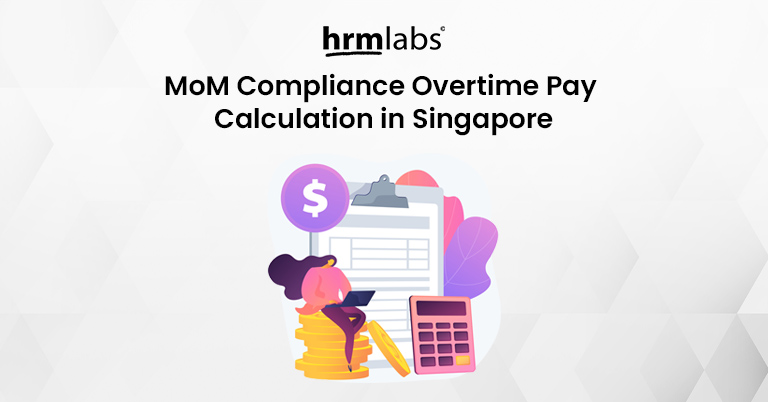Overtime pay is a legal entitlement for many employees in Singapore who work beyond their normal hours of work. As an employer, you need to know how to calculate overtime pay correctly and pay your employees on time. This will help you comply with the Employment Act and avoid disputes or penalties.
In this article, we will explain who is eligible for overtime pay, how to calculate overtime pay, and what are the rules and exceptions for overtime work.
Who is eligible for overtime pay?
According to Part IV of the Employment Act, overtime pay only applies to:
- A workman (i.e., an employee doing manual labour) earning a basic salary of up to $4,500 per month.
- A non-workman (i.e., an employee doing non-manual work) earning a basic salary of up to $2,600 per month.
A workman is someone whose work involves mainly manual labour, such as a cleaner, construction worker, or factory worker. A non-workman is someone whose work does not involve mainly manual labour, such as an office worker, teacher, or nurse.
These salary thresholds were revised on 1 April 2019. For overtime work done before 1 April 2019, the salary thresholds were $4,500 for workmen and $2,500 for non-workmen.
Note that managers and executives are not covered by Part IV of the Employment Act. Normally they are not entitled to overtime pay, regardless of their salary level.
How to calculate overtime pay?
Overtime work is any work done beyond the normal hours of work, excluding breaks. The normal hours of work are:
- Up to 9 hours per day or 44 hours per week for employees who work 5 days or less a week.
- Up to 8 hours per day or 44 hours per week for employees who work more than 5 days a week.
For other work arrangements, such as shift work or flexible work, the normal hours of work are:
- Up to 48 hours per week, but capped at 88 hours in any continuous 2-week period. For employees who work less than 44 hours every alternate week.
- Up to an average of 44 hours over a continuous 3-week period. For employees who work shifts of up to 12 hours a day.
For overtime work, employers must pay their employees at least 1.5 times the hourly basic rate of pay. The hourly basic rate of pay is calculated by dividing the monthly basic salary by 26 (the average number of working days in a month) and then by the normal daily hours of work.
Calculation example
For example, if an employee earns a monthly basic salary of $2,400 and works 8 hours a day for 5 days a week, his or her hourly basic rate of pay is:
$2,400 / 26 / 8 = $11.54
If he or she works 2 hours of overtime on a weekday, his or her overtime pay is:
$11.54 x 1.5 x 2 = $34.62
The overtime rate payable for non-workmen is capped at the salary level of $2,600, or an hourly rate of $13.60. This means that if a non-workman earns more than $2,600 per month, his or her overtime pay will be based on $2,600 or $13.60 per hour, whichever is lower.
For example, if a non-workman earns a monthly basic salary of $3,000 and works 8 hours a day for 5 days a week, his or her hourly basic rate of pay is:
$3,000 / 26 / 8 = $14.42
However, since this exceeds the cap of $13.60 per hour, his or her overtime pay will be based on $13.60 per hour instead. If he or she works 2 hours of overtime on a weekday, his or her overtime pay is:
$13.60 x 1.5 x 2 = $40.80
Employers must pay their employees for overtime work within 14 days after the last day of the salary period.
What are the rules and exceptions for overtime work?
There are some rules and exceptions that employers and employees should be aware of when it comes to overtime work.
- Employees are generally not required to work more than 6 consecutive hours without a break. However, if the nature of the work requires continuous work for up to 8 hours, breaks must be provided for meals. The breaks should be at least 45 minutes long.
- Employees should not work more than 12 hours a day or more than an average of 44 hours a week over any continuous period of up to 12 weeks. If they do so, they must give their consent in writing and be informed. About their daily working hours, number of working days in each week and weekly rest day.
- Employees are entitled to one rest day per week without pay. The rest day is usually Sunday, but can be any other day of the week as agreed between the employer and the employee. If an employee works on his or her rest day. He or she must be paid at least 2 times the hourly basic rate of pay for the first 8 hours of work. Then, at least 3 times the hourly basic rate of pay for work beyond 8 hours.
- Employees are entitled to overtime pay for work done on a public holiday only if they are required by their employer to work on that day. The overtime pay for work done on a public holiday is at least 2 times the hourly basic rate of pay.
- Some employees may be exempted from overtime pay if they fall under certain categories, such as seamen, domestic workers, security officers, or employees engaged in managerial or executive positions. Employers should check with the Ministry of Manpower (MOM) for the full list of exemptions and conditions.
Why is it important to comply with the overtime pay regulation?
Complying with the overtime pay regulation is not only a legal obligation, but also a good business practice. It shows that you respect your employees’ rights and welfare, and that you value their contributions and efforts. This can help you attract and retain talent, boost morale and productivity, and reduce turnover and absenteeism.
On the other hand, failing to comply with the overtime pay regulation can have serious consequences. You may face complaints or disputes from your employees, investigations or audits by MOM, or penalties or prosecution for breaching the Employment Act. You may also damage your reputation and credibility as an employer, and lose your competitive edge in the market.
Therefore, it is important to keep track of your employees’ working hours and overtime work. Calculate and pay their overtime pay correctly and promptly, and adhere to the rules and exceptions for overtime work. You should also communicate clearly with your employees about their overtime entitlements and obligations. To seek their consent and feedback when necessary.
Streamline the process with HRMLabs

Streamlining the calculation of overtime pay can greatly benefit your organization. By utilizing the Payroll and Attendance and Scheduling features from HRMLabs, you can automate the process, ensuring accurate and compliant calculations. The Time Attendance System allows you to easily track employee attendance, work patterns, and overtime hours. While the Payroll Software simplifies payroll processing and ensures regulatory compliance. With features such as automated payroll calculation, easy payment processing, and up-to-date government regulation updates. HRMLabs provides a comprehensive solution to streamline your overtime pay calculations. Take advantage of these tools to save time, reduce errors, and ensure a smooth and efficient payroll process.



